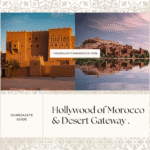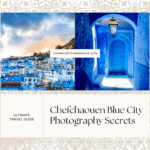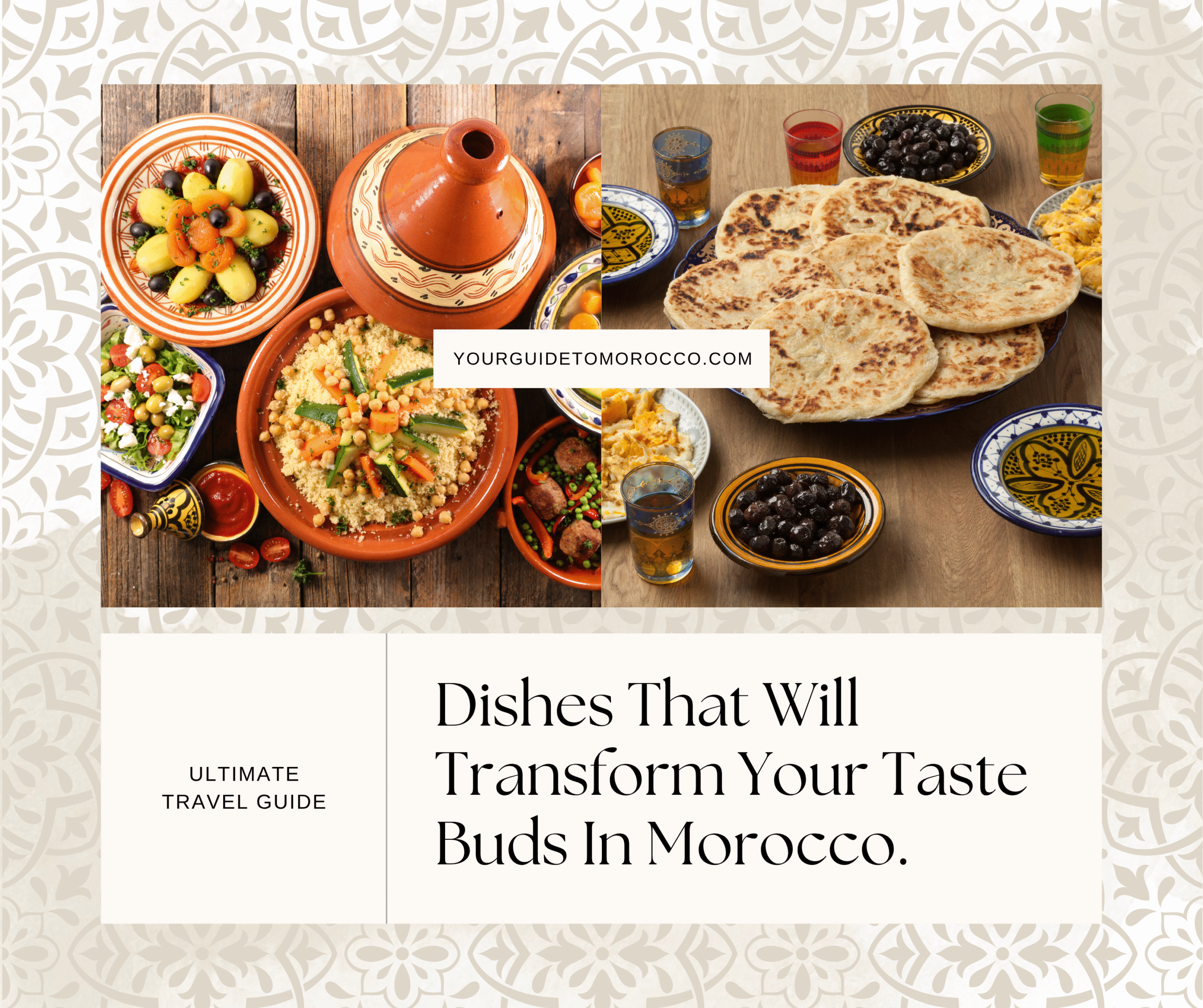
The Ultimate Guide to Moroccan Food: 15 Must-Try Dishes That Will Transform Your Taste Buds
Table of Contents
Picture this: you’re wandering through the labyrinthine souks of Marrakech, and suddenly you’re hit with an intoxicating wave of cinnamon, cumin, and saffron dancing through the air. Your stomach growls—not from hunger, but from pure anticipation. Welcome to Morocco, where food isn’t just sustenance; it’s poetry written in spices, stories told through slow-cooked stews, and hospitality served on ornate silver platters.
Moroccan cuisine isn’t just about eating—it’s about experiencing a culture that’s been perfecting the art of flavor for over a thousand years. Think of it as the ultimate fusion before fusion was even a thing, where Berber traditions meet Arabic influences, with a dash of French finesse and a sprinkle of Spanish flair.
But here’s the thing: navigating Morocco’s culinary landscape can feel overwhelming when you’re staring at a menu written entirely in Arabic. Which tagine should you order? Is that street vendor’s couscous safe to eat? And what exactly makes Moroccan food so irresistibly different from anything you’ve tasted back home?
Don’t worry—we’ve got you covered. This isn’t your typical food guide filled with pretentious descriptions and impossible-to-pronounce names. Instead, think of this as your culinary GPS through Morocco’s most delicious destinations, complete with insider tips that’ll have you eating like a local faster than you can say “bismillah.”
1. Tagine: The Crown Jewel of Moroccan Cuisine
Let’s start with the obvious superstar—the tagine. But before you roll your eyes thinking “everyone knows about tagine,” let me blow your mind with what you probably don’t know.
What is a tagine, and how is it made? Here’s where things get interesting. A tagine isn’t just a dish—it’s also the conical clay pot it’s cooked in. The genius lies in that funky hat-shaped lid that creates a perfect steam circulation system. Moisture rises, hits the cool lid, condenses, and drips back down, creating this incredible self-basting mechanism that would make your grandmother’s slow cooker weep with envy.
The most popular varieties you’ll encounter:
- Chicken tagine with preserved lemons and olives: Tangy, aromatic, and absolutely foolproof for first-timers
- Lamb tagine with apricots and almonds: Sweet meets savory in the most gorgeous way possible
- Vegetarian tagine with seven vegetables: Because Morocco does plant-based better than most trendy LA restaurants
Pro tip: The best tagines simmer for hours, so don’t expect fast food. Good things take time, and Moroccan cooks have mastered the art of patience.
2. Couscous: Not Your Average Grain
Friday in Morocco means one thing: couscous. This isn’t the instant stuff you grab from the supermarket shelf—this is the real deal, hand-rolled and steamed to fluffy perfection.
How is couscous traditionally prepared and served? Picture this: families gather around enormous platters, everyone eating with their hands from the same dish. It’s communal dining at its finest, and honestly, it tastes better when you’re sharing.
Traditional couscous comes with:
- Tender vegetables (carrots, turnips, zucchini)
- Succulent meat (usually lamb or chicken)
- A rich, aromatic broth that’s been simmering since dawn
- Chickpeas for that extra protein punch
The preparation involves a special pot called a couscoussière—basically a steamer that transforms tiny semolina granules into clouds of deliciousness. Watching a Moroccan grandmother work her couscous magic is like witnessing culinary ballet.
3. Harira: The Soul-Warming Soup
Harira is Morocco’s answer to chicken noodle soup, except it’s infinitely more complex and satisfying. This tomato-based soup packed with lentils, chickpeas, and tender pieces of meat becomes particularly special during Ramadan, when it’s traditionally the first thing people eat to break their fast.
But here’s what makes harira special: it’s thickened with a mixture called tedouira—flour whisked with water and herbs. This gives the soup its distinctive velvety texture that coats your spoon like liquid velvet.
Insert image of steaming bowl of harira with fresh herbs garnish here
4. Pastilla: The Sweet-Savory Masterpiece
If pastilla were a person, it would be that intriguingly complex friend who surprises you every time you hang out. This flaky pastry pie traditionally filled with pigeon (though chicken is more common now) combines sweet and savory in ways that shouldn’t work but absolutely do.
Picture layers of paper-thin pastry filled with spiced meat, topped with a mixture of almonds, sugar, and cinnamon. It’s dusted with powdered sugar and served as a starter. Yes, meat with sugar. No, it’s not weird once you taste it.
5. Khobz: The Foundation of Every Meal
Moroccan bread (khobz) isn’t just bread—it’s your utensil, your plate, and your companion throughout every meal. This round, flat bread with its distinctive crusty exterior and soft interior is baked in communal ovens throughout Morocco.
Here’s something cool: many families don’t have ovens at home, so they prepare their bread dough and take it to the neighborhood baker. Each family has their own mark to identify their loaves. It’s like a delicious postal system.
Are there vegetarian or vegan options in Moroccan food? Absolutely! Khobz is typically vegan, and it’s served with numerous plant-based dishes like zaalouk and various vegetable tagines.
6. Moroccan Mint Tea: Liquid Hospitality
You haven’t truly experienced Morocco until you’ve participated in the elaborate ritual of Moroccan mint tea. This isn’t just a beverage—it’s a ceremony, a peace offering, and a social lubricant all rolled into one.
What is Moroccan mint tea, and why is it significant? The preparation involves gunpowder green tea, fresh mint, and lots of sugar, poured from great heights to create that signature foam. The pouring technique isn’t showing off—it actually aerates the tea and mixes the ingredients perfectly.
Insider secret: Refusing tea when offered is considered rude, but don’t worry—it’s absolutely delicious and surprisingly refreshing even in the desert heat.
7. Zaalouk: The Moroccan Baba Ganoush
Zaalouk is what happens when eggplant meets tomatoes in a slow-cooked love story. This smoky, chunky dip is served at room temperature and makes an incredible starter with fresh bread.
The secret lies in cooking the eggplant until it’s completely surrendered its bitterness, then combining it with tomatoes, garlic, and a blend of spices that includes cumin, paprika, and preserved lemons.
8. Street Food Adventures: Eating Like a Local
Is street food safe to eat in Morocco? Here’s the truth: use common sense. Look for busy stalls with high turnover, avoid anything that’s been sitting in the sun for hours, and trust your nose. Some of the best meals you’ll have in Morocco will come from street vendors.
Must-try street foods:
- Msemen: Flaky, buttery pancakes perfect for breakfast
- Brochettes: Grilled meat skewers with perfect char
- Fresh orange juice: Squeezed right in front of you from the sweetest oranges
- Chebakia: Sesame and honey pastries that are pure edible art
Insert image of bustling Moroccan street food market with colorful displays here
9. Spice Market Magic: The Heart of Moroccan Flavors
What spices are commonly used in Moroccan cuisine? Welcome to flavor town, where spice blends have names like poetry and aromas that could make a grown person weep with joy.
Essential Moroccan spices:
- Ras el hanout: The “top of the shop” blend with up to 30 spices
- Cumin: Earthy and warm, used in almost everything
- Cinnamon: Sweet and spicy, perfect for both savory and sweet dishes
- Saffron: The golden threads that make rice dishes extraordinary
- Preserved lemons: Tangy, salty perfection that brightens every dish
Shopping tip: Buy spices from busy spice stalls in the souks—the turnover ensures freshness, and you can often negotiate better prices.
10. Breakfast Traditions: Starting the Day Right
What are typical Moroccan breakfast foods? Forget your rushed coffee-and-croissant routine. Moroccan breakfasts are leisurely affairs designed to fuel you for the day ahead.
Traditional breakfast includes:
- Fresh khobz with olive oil and honey
- Amlou: A heavenly spread made from almonds, argan oil, and honey
- Moroccan pancakes (msemen or rghaif)
- Strong coffee or mint tea
- Fresh seasonal fruits
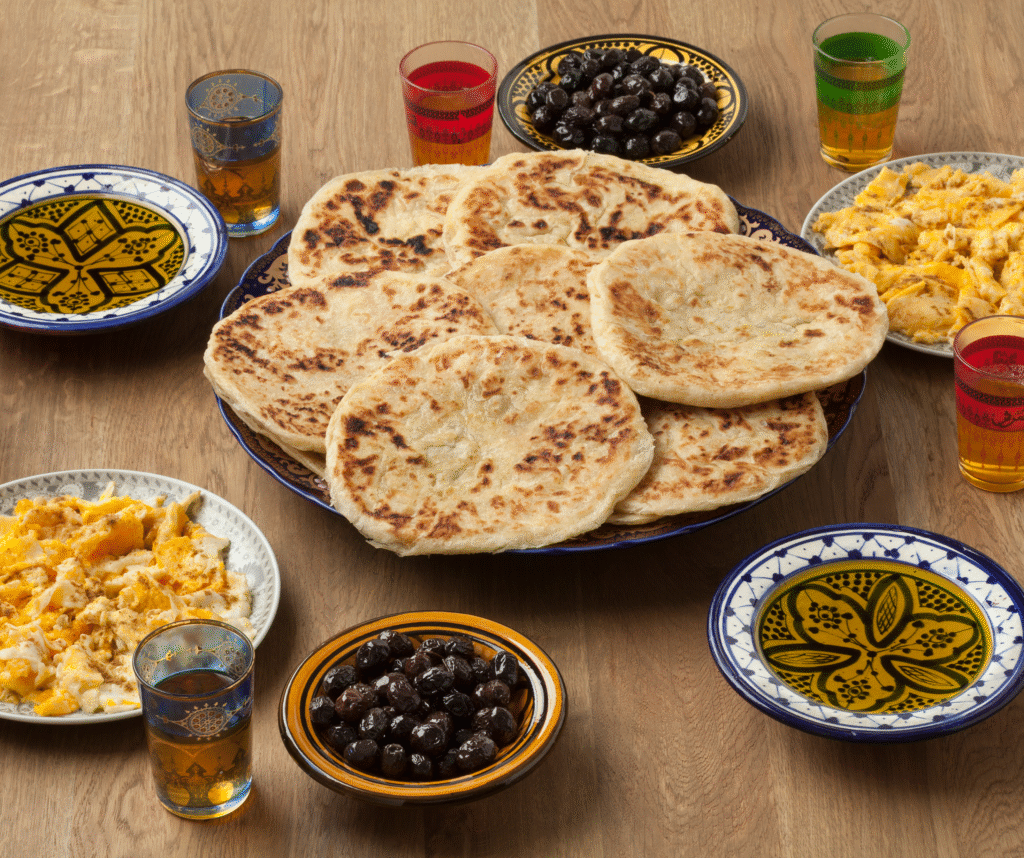
11. Lamb: The Protein of Choice
Do most Moroccan dishes include meat? While not all dishes contain meat, lamb holds a special place in Moroccan hearts and stomachs. Moroccan lamb dishes are legendary for their tenderness and complex spicing.
The secret? Slow cooking with aromatic spices until the meat falls off the bone. Whether it’s in a tagine, couscous, or grilled as brochettes, Moroccan lamb is consistently exceptional.
12. Ramadan Specialties: Festival Foods
Moroccan food for Ramadan takes on special significance during the holy month. Families gather for iftar (breaking the fast) with specific dishes that provide comfort and nourishment.
Traditional Ramadan foods:
- Chebakia: Intricate sesame cookies soaked in honey
- Sellou: An energy-packed mixture of almonds, sesame, and flour
- Dates: The traditional way to break the fast
- Harira soup: Essential for rehydration and nutrition
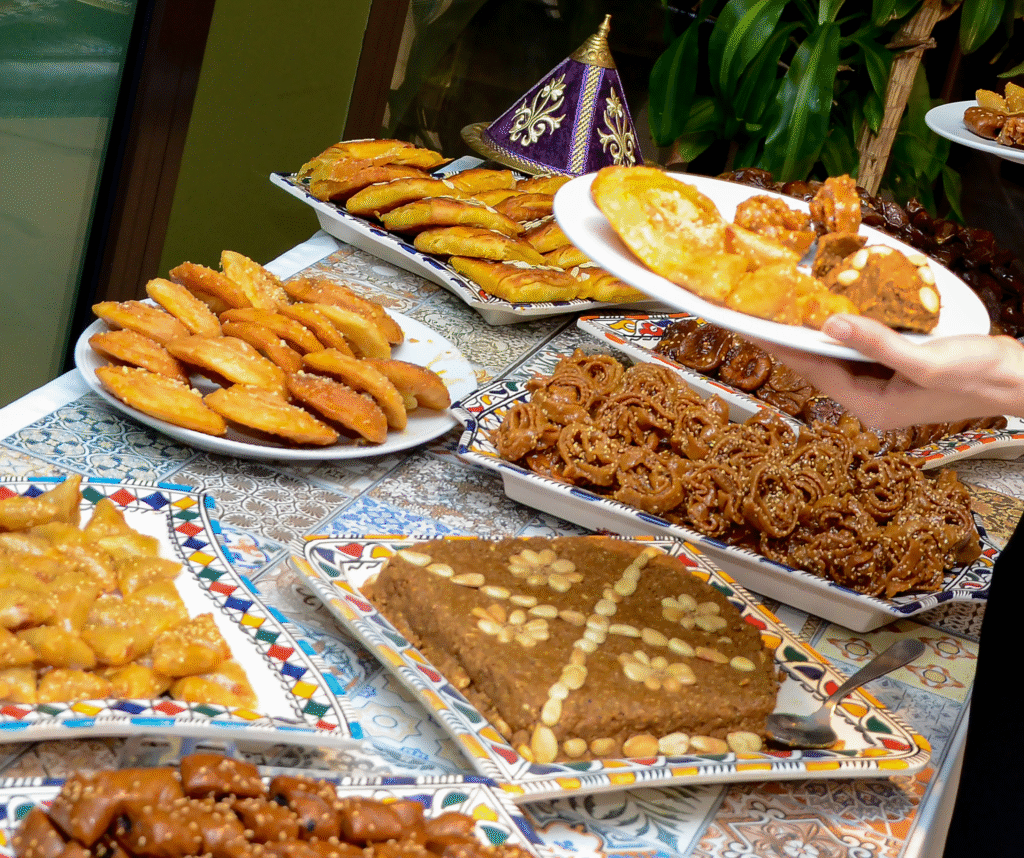
13. Regional Specialties: Beyond the Classics
Are there foods unique to Morocco not found elsewhere? Absolutely! Morocco’s diverse regions each contribute unique specialties:
- Tanjia (Marrakech): Slow-cooked meat in an amphora-shaped pot
- Rfissa (Casablanca): A comfort dish with chicken and lentils over torn msemen
- Couscous with seven vegetables (Fez): The ultimate vegetarian feast
- Fish chermoula (Coastal cities): Fresh seafood with herb marinades
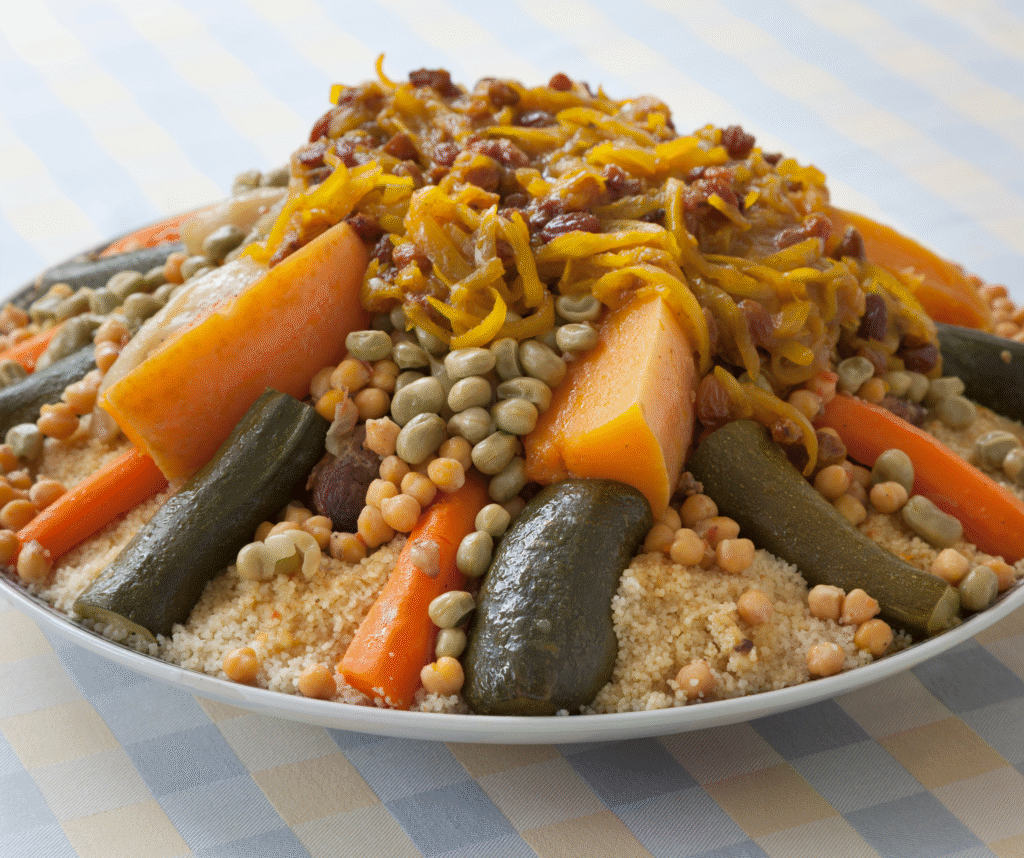
14. Sweet Endings: Moroccan Desserts
What desserts are traditional in Moroccan cuisine? Moroccan sweets are works of art that happen to be edible. These aren’t your everyday desserts—they’re special occasion treats that require skill and patience.
Must-try desserts:
- Chebakia: Rose-shaped pastries with sesame and honey
- Ghriba: Crumbly almond cookies that melt in your mouth
- Muhallabia: Creamy milk pudding with rose water
- Ma’amoul: Date-filled cookies perfect with mint tea
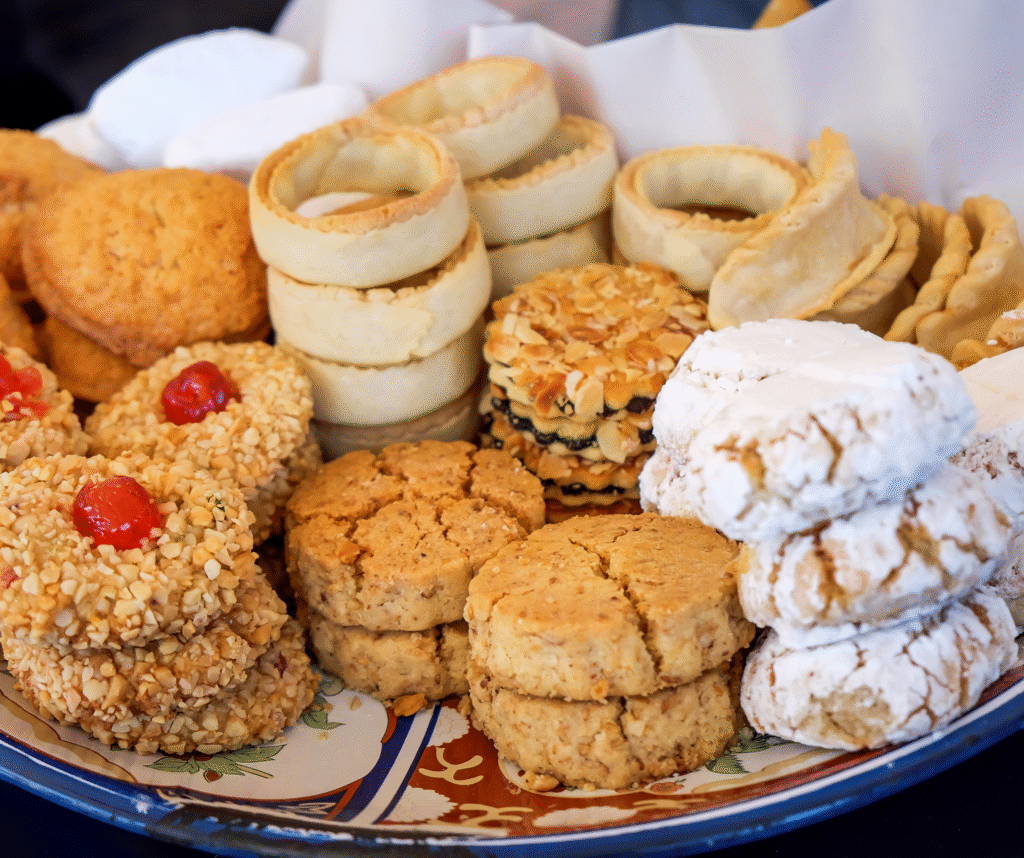
15. Making It at Home: Your Moroccan Kitchen Essentials
Ready to bring Morocco home? Here’s what you need for authentic Moroccan food recipes:
| Essential Equipment | Where to Find | Why You Need It |
| Tagine pot | Amazon, Moroccan shops | Authentic slow-cooking |
| Couscoussière | Specialty cookware stores | Perfect couscous texture |
| Preserved lemons | Gourmet markets, online | Authentic tangy flavor |
| Ras el hanout | Spice shops, Amazon | Complex spice blend |
| Moroccan mint | Middle Eastern grocers | Fresh tea preparation |
Easy Moroccan recipes to start with:
- Chicken tagine with olives – Foolproof and forgiving
- Moroccan vegetarian dishes like zaalouk – Simple and healthy
- Moroccan salads with preserved lemons – Fresh and bright
Your Culinary Adventure Awaits
Moroccan food culture is about more than just eating—it’s about connection, hospitality, and the joy of sharing incredible flavors with others. Whether you’re planning a trip to Morocco or just want to spice up your home cooking, understanding these dishes will enrich your appreciation for one of the world’s great cuisines.
The beauty of Moroccan cuisine lies not just in its complexity, but in its heart. Every dish tells a story of trade routes and cultural exchange, of families gathering around communal platters, of the patient art of slow cooking in a fast world.
Is Moroccan food spicy or mild? Here’s the beautiful thing—it’s all about layers of flavor rather than heat. The spices create warmth and depth without overwhelming your palate. It’s sophisticated, nuanced, and absolutely addictive.
So whether you’re navigating the bustling food markets of Marrakech or experimenting with Moroccan dinner ideas in your own kitchen, remember that the best Moroccan meals are eaten slowly, shared generously, and savored completely.
Your taste buds will thank you, and who knows? You might just discover that the secret ingredient in every great Moroccan dish isn’t actually a spice at all—it’s the love and hospitality that goes into every single bite.
Insert image of diverse group of travelers enjoying a traditional Moroccan feast together here
Ready to embark on your own Moroccan culinary adventure? Start with that tagine pot, grab some ras el hanout, and prepare to transform your kitchen into a Marrakech medina. Your dinner guests will never see you the same way again.
16. Making Moroccan Food at Home: Your Kitchen Essentials
Ready to bring Moroccan food home?
Here’s what you need for authentic Moroccan food recipes:
| Essential Equipment | Where to Find | Why You Need It |
| Tagine pot | Amazon, Moroccan shops | Authentic Moroccan food slow-cooking |
| Couscoussière | Specialty cookware stores | Perfect Moroccan food couscous texture |
| Preserved lemons | Gourmet markets, online | Authentic Moroccan food tangy flavor |
| Ras el hanout | Spice shops, Amazon | Complex Moroccan food spice blend |
| Moroccan mint | Middle Eastern grocers | Fresh Moroccan food tea preparation |
Easy Moroccan food recipes to start with:
- Chicken tagine with olives – Foolproof and forgiving Moroccan food
- Moroccan vegetarian dishes like zaalouk – Simple and healthy Moroccan food
- Moroccan salads with preserved lemons – Fresh and bright Moroccan food
Learn from professional chefs with these authentic Moroccan cooking classes available online and in Morocco.
For the best Moroccan food ingredients, visit Williams Sonoma’s Moroccan collection or explore local Middle Eastern markets in your area.
Essential Moroccan Food Safety Tips for Tourists
When exploring authentic Moroccan food during your travels, keep these safety guidelines in mind:
- Choose busy restaurants with high turnover
- Opt for hot, freshly cooked Moroccan food
- Drink bottled water with your Moroccan food meals
- Trust your instincts about Moroccan food vendors
For comprehensive travel health information, consult the CDC’s Morocco travel guidelines before your trip.
Ready to Explore Fes? Let’s Make It Happen!
Turn your Morocco dreams into reality with our expert local guidance and authentic cultural experiences.
Get in Touch:
Email: contact@yourguidetomorocco.com
WhatsApp: +212 718448804
Website: www.yourguidetomorocco.com
Phone: +212 718448804
Connect With Us:
Instagram: @yourguidetomorocco | Facebook: Your guide to morocco | TikTok: @yourguidetomorocco
Quick Response Promise:
- WhatsApp: Instant replies during business hours
- Email: Response within 24 hours
- Custom quotes: Tailored to your travel dates and preferences
Ready to book your Fes adventure? Message us now for personalized recommendations and exclusive local insights!


